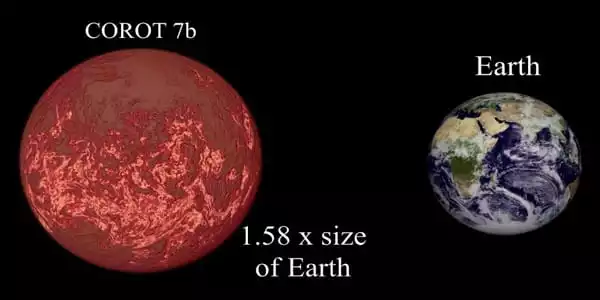CoRoT-7 b is an exoplanet that circles a K-type star. It has a mass of 4.07661 Earths, takes 0.9 days to complete one orbit around its star, and is 0.017016 AU away from it. It is a planet roughly 70% larger than Earth that orbits a Sun-like star. It is the first rocky exoplanet identified and has thus been termed a “super-Earth.” It was discovered in 2009 and was announced.
CoRoT-7b is an exoplanet 489 light-years from Earth that orbits the star CoRoT-7 in the constellation Monoceros. It is the first extrasolar planet discovered to be a rocky planet similar to Earth. It was discovered photometrically by the French-led CoRoT mission in February 2009 and reported. Until the release of Kepler-10b in January 2011, it was the smallest exoplanet whose diameter had been measured, at 1.58 times that of the Earth (giving it a volume of 3.95 times that of the Earth), and the first putative extrasolar terrestrial planet to be discovered. The planet’s orbital period is incredibly brief, rotating around its host star in around 20 hours. It orbits its star at a distance of 2.6 million kilometers every 0.85 days (1.6 million miles).
The combination of the planet’s diameter calculated from transit data and its mass derived from radial velocity measurements meant that the density of CoRoT-7b was roughly the same as that of Earth, implying that CoRoT-7b was a terrestrial planet like Earth rather than a gas giant like Jupiter. CoRoT-7’s radial velocity observations also revealed the existence of a second super-Earth, CoRoT-7c, which has a mass 8.4 times that of Earth and orbits at a distance of 6.9 million kilometers every 3.7 days (4.3 million mi).

Discovery
CoRoT-7b was found by observing its parent star’s periodic decrease in apparent magnitude caused by the planet’s transit in front of the star as seen from Earth. Measuring this dip in brightness, together with a size estimate for the star, allows calculating the planet’s size. The space mission CoRoT observed the star CoRoT-7, in the stellar field LRa01, from October 15, 2007, to March 3, 2008. During this period, 153 periodic transit signals of 1.3 h duration with a depth of 3.4 × 10−4 were registered. After 40 days of data acquisition, the Alarm mode pipeline algorithm detected the shallow signal of CoRoT-7b, starting the follow-up observations from the ground to get a confirmation of the planetary nature of the transiting object.
A year later, on February 3, 2009, the discovery of CoRoT-7b was revealed at the CoRoT Symposium 2009 in Paris. It was published in a special issue of Astronomy and Astrophysics devoted to CoRoT findings.
Mass
Following the finding of CoRoT-7b in the lightcurve, follow-up observations using a network of ground-based telescopes ruled out the chance of a false positive detection almost completely. The mass of CoRoT-7b was then measured using the radial velocity approach using the HARPS spectrograph. The mass determination was complicated by the host star’s high activity, which disrupted radial velocity measurements.
The discovery paper, by Queloz et al., weighed the planet at about 4.8 Earth masses, giving it a density of 5.6 ± 1.3 g cm−3, similar to Earth’s. The value was obtained using a pre-whitening procedure and harmonic decomposition. It was also inferred that there was a second non-transiting planet in the system, CoRoT-7c, with a 3.7-day orbital period.
The CoRoT team then published a second report on the mass of CoRoT-7b, excluding stellar activity by analyzing just radial velocity data from several measurements collected in a single night. The planet is 7.42 Earth masses in mass, with an average density of 10.4 ±1.8 g cm-3 that is significantly higher than the Earth’s and similar to that of the second discovered rocky planet, Kepler-10b.
Ferraz-Mello et al. refined the approach employed in the discovery paper, discovering that it reduced the amplitude of the planets’ generated radial velocities. It reports a heavier mass of 8 Earth masses for CoRoT-7b, which is consistent with the second publication published by the CoRoT team. Thus, CoRoT-7b may be rocky with a large iron core, with an internal structure more like Mercury than Earth.
















